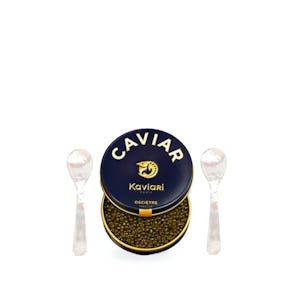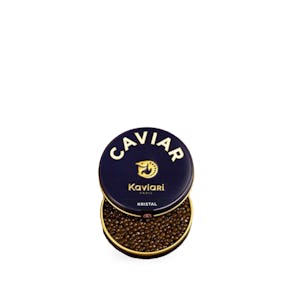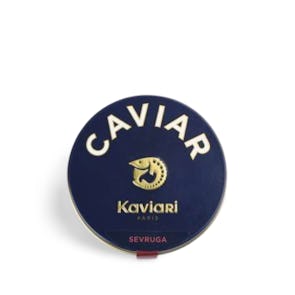Caviar: A History and a Definition
So much for something so delicate and delectable.
Caviar was one of the very first delicacies, coveted by kings and the aristocracy. It originated in Persia, which is now modern-day Iran, and first prepared and enjoyed by their people. The word “caviar,” comes from the Persian word, “khavyar,” (pronounced as written), which means “cake of strength,” or “cake of power,” as they attributed many medicinal powers to it.
So regaled was this delicacy even at the very beginning, that when it was first recorded in 4th century BC by Greek scholar, Aristotle, he tells of caviar entering banquets accompanied by trumpets and flowers. It was catapulted even further into the world of luxury by Russian tsars, who enjoyed a type of golden roe from the Sterlet sturgeon, and was regarded as “imperial caviar,” and served to Russian, Austrian, and Iranian royalty. Caviar eventually made its way across Europe, where one jar cost about one hundred sheep in 2nd century BC, making it exclusive to higher class citizens.

Aristotle tells Plato all about Caviar.
So Aristotle, how good is this caviar you speak of?
But what is caviar? And where exactly does it come from? There are many products labeled “caviar” on the market, but true caviar is unpasteurized roe that comes specifically from sturgeons. Traditionally, from wild sturgeon found in the Caspian Sea and the Black Sea.
Russia and Iran used to be top of the game, but the modern-day caviar industry leader is China, taking up about 60% of world caviar production. They’re followed closely by Italy and France. Many caviar producers have been relying on farming caviar, in attempts to preserve endemic species, like the European sturgeon (Acipenser sturio) in France, the white sturgeon (Acipenser transmontanus) in the USA, the Kaluga in China, and the Adriatic sturgeon in Italy. And there are special cases like Uruguay, a country with no local sturgeon presence, that set up sturgeon farms on the banks of the Rio Negro, and is now Latin America’s number one caviar exporter.
Good, high-quality caviar is mild and fresh in flavor, with a subtle saltiness and brininess. It’s not overpowering on the palate, and it gives off a pleasantly unexpected buttery sort of richness.
Its texture is an experience in itself. The bead-like roe will roll and slide across your tongue and the roof of your mouth. It should be firm and smooth, with no distinct oiliness. And when you bite into the beads, it will give off a nice pop and release a burst of flavor.
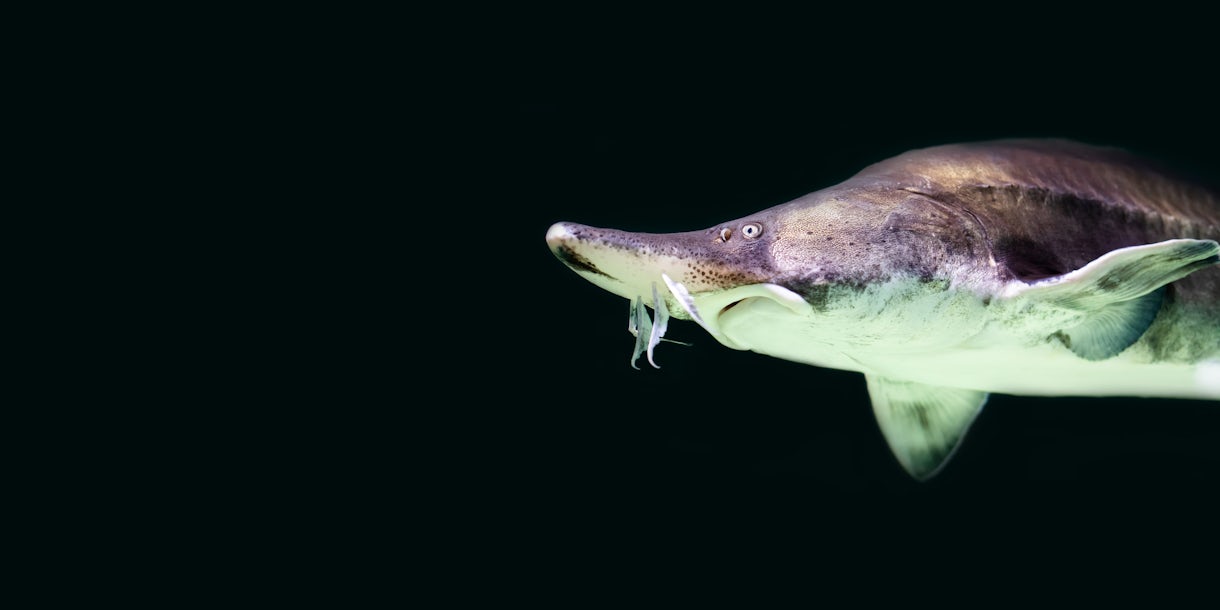
A Beluga European sturgeon.
Types of Caviar You Should Know
Many traditionalists will argue that true caviar only comes from sturgeons while modern connoisseurs will offer other alternatives like salmon, vendace, or herring. But there are many different kinds of true caviars, each with their own slightly distinct characteristics.
• Ossetra is one of the most popular types, coming from Ossetra sturgeons and producing smaller eggs, with a buttery, creamy flavor and briny notes.
• Kaluga caviar, on the other hand, comes from the hybrid Kaluga sturgeon, native to the Amur River basin. The Kaluga caviar gives an earthy, buttery, mildly salty flavor.
• Found mainly in the waters of Siberia, we have the Baeri caviar, which are small and dark beads that have a subtle but pure briny flavor, and hints of hazelnut.
• Similar in look are the small black eggs from the Sevruga sturgeon, the smallest of the caviar-producing sturgeons. Sevruga caviar is smooth and buttery, with a delicate aroma.
• Transmontanus caviar is another, taken from the White Sturgeon found mainly in the area of the Gulf of Alaska to Monterey, California. These are dark gray regular-sized beads, with a mild, nutty flavor and floral undertones.
• And of course, there is the Beluga caviar, the most expensive caviar on the market. It comes from the rare beluga sturgeon found in the Caspian Sea, which is bordered by Iran, Russia, Kazakhstan, Azerbaijan, and Turkmenistan. It’s also farmed, mainly in Bulgaria. It’s the most famous caviar in the world, and the rarest and most sought-after. Its aroma is elegant and rich, barely having a fishy odor, and its taste is beautifully buttery, with creamy, nutty notes. Beluga caviar also has the biggest individual egg size, and the highest nutritional value of all the caviars.
Fact, Beluga sturgeons belong to the oldest group of fishes. Estimated over 200 million years old..
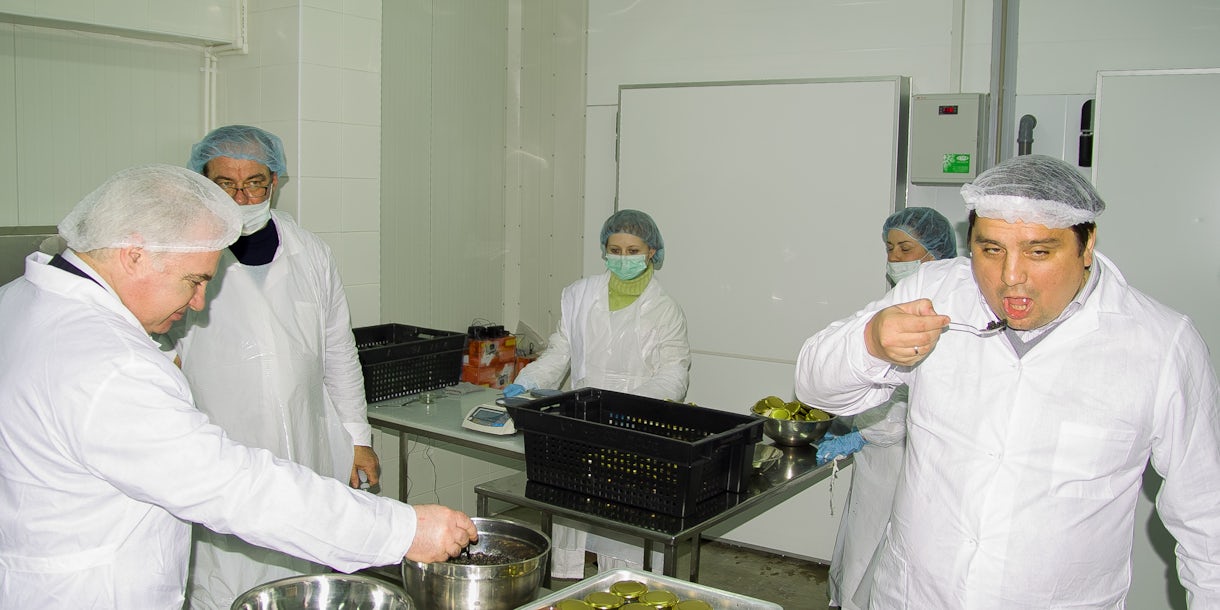
A Sturgeon plant in the Kaluga region of Russia. Someone's about to do some "testing".
Don't worry! One more spoonful and I'm sure this will pass.
True caviar is also organic, containing no pesticides, additives, hormones, or antibiotics. The way to obtain it, though, is not the most sustainable. Traditionally, the sturgeon is killed to obtain its roe. Many producers still use this method, as it truly is still the best way to ensure freshness and pure flavor. Modern technology, however, has developed more sustainable methods that many companies employ. But no matter the method of their extraction, the eggs or roe are always removed by hand with great meticulousness.
After being harvested, the roe is screened for quality. Then comes the preparation, where they are rinsed to wash away impurities, before salt is added in precise amounts for taste and preservation. Then they are graded, and carefully packed in lacquer-lined tins.
The Pinnacle of Luxury
We’ve mentioned that caviar is unfortunately not very sustainable, but that’s only one of the reasons this delectable luxury is priced the way it is. There are a number of other cost factors when it comes to caviar.
The type of fish is a factor—the rarer the fish, the more expensive the product. That honor, as far as market prices go, and as aforementioned, goes to Beluga. Another important factor to consider is that female sturgeons generally take around 10 to 15 years before maturing and producing eggs, which means the waiting game and the care that goes into the fish can be costly. Another is that harvesting the roe is a delicate process, one that requires a lot of expertise and precision.
The roe is also graded, but that is not to mean that one grade is better than the other. Grade 1 is given to roe that are large and firm, intact but delicate, with a fine, even color and mild flavor. Grade 2 is for roe that is usually smaller, with more tanginess in its flavor. And of course, we can’t ignore the supply and demand in accordance with the consumer market.
This combination—rare, non-renewable, and in high demand—is why caviar costs the way it does. And how much would this delicacy cost you, exactly? Well, generally, you can expect to shell out at least about $65 (~₱3,000) for 30 grams of sturgeon roe, with the higher quality ones starting at about $100 (~₱5000). If you see caviar on a restaurant menu, the price can go even higher, with caviar service costing around $100.
In the Philippines, it’s called “puga” or “bihud” in Tagalog, and is sold in specialty stores around the country, both online and brick-and-mortar. Caviar in the Philippines has a price range of about ₱2,500 to ₱23,000.
But amazingly, that is not the highest a caviar can cost. Beluga caviar is the most expensive caviar that is readily available, but there is a caviar that will trump its exclusivity, no question.
With its price comparable to that of a precious gemstone, the Almas caviar is the most expensive caviar in the world. Its name, almas, means “diamond” in Russian, and both its look—golden in color—and its value, are reminiscent of the prized stone.
Almas caviar comes exclusively from the albino beluga sturgeon living in the Caspian Sea, mostly in the unpolluted waters near Iran. Beluga sturgeons are already rare, albino beluga sturgeons even more so. These sturgeons are also between 60 to 100 years of age when their eggs are harvested. As the sturgeon grows older, their eggs become smoother, more aromatic, and more elegant.
Almas is distinct in character, delicious, with a spongier texture. It’s complex, richly nuanced, with an intense nutty, creamy taste. It also comes in a special metal tin that is covered in 24-karat gold, further emphasizing its luxuriousness. A kilo of Almas caviar can cost at least $25,000 (~₱1.2 million).
How to Choose Your Caviar
Now that you know some basic things about caviar, you might be inclined to try some yourself. But, of course, there is still some information that you might be wondering about.
Choosing a caviar to buy can be a little daunting, but it truly all boils down to personal tasting preferences. Remember that price is determined mostly by the size of the beads, complex manufacturing techniques, and rarity. The most expensive tin may not necessarily be the best one for you, as it really does depend on if you want something on the mild side, or one with more intense flavor.
You can consider sources and brands before you buy. Kaviari, Dom Petroff, and Faye, are brands that work with quality farms around the world, curating only the best caviars for you. Then there are brands like Prunier, Riofrio, and Polanco, that have more of a farm-to-table approach, and get their caviar from their own sturgeon farms.
Consider how many people will be enjoying the caviar, too, so you don’t end up buying too much. This is a perishable good, and although it will be fine after a day in the refrigerator, it is still best to consume it immediately. you can also consider the occasion in which you are serving your caviar.
If it’s for a solo, self-care day (and you deserve it), pick a caviar suited to your taste preference, and maybe grab a bottle of Champagne, too. For something special, like an anniversary, you can opt for the higher quality ones. A simple, elegant dinner party with a small crowd would do with something cheaper (in price, but never in quality), so you can buy a little more without burning a hole through your pocket.
And if you’re sharing, it will be prudent to know serving size: half to one ounce (14 to 28 grams) of caviar per person, would suffice. Another thing to remember is to always serve it cold, at 26 to 35F, or 0 to 4C. The Russian way of serving is usually without ice. In Europe, it is served in a special caviar bowl on a bed of crushed ice.
And serving caviar can be considered an artform in itself. Traditionally, mother-of-pearl or gold dishes and utensils are used to serve it. Alternatives are glass, bone, and sometimes, wood. Yes, this can sound fussy, but silver and metallic bowls and utensils can cause oxidation and alter and impair the taste of the caviar. It is also not recommended to transfer the roe from the tin to a serving bowl because the eggs are very delicate, and might break. These tins are lined with non-reactive interior linings to prevent contact with the caviar itself.
And we do have to mention the caviar spoon. Yes, a spoon specifically for serving and eating caviar. Traditionally, caviar spoons are made out of inert—or non-reactive—materials, like mother-of-pearl, gold, animal horn, bone, or wood. Plastic can even be used. One is not necessarily better than another; what is important is the spoon’s non-reactive nature. Although, let’s admit it, eating off a gold or pearl spoon is infinitely more luxurious, and just goes with the overall feel of the delicacy.
We know it’s a lot to take in. A lot of information to remember and take note of even before you dig in. But we promise, it will make your caviar experience so much more memorable.
And now, you’re ready to eat!
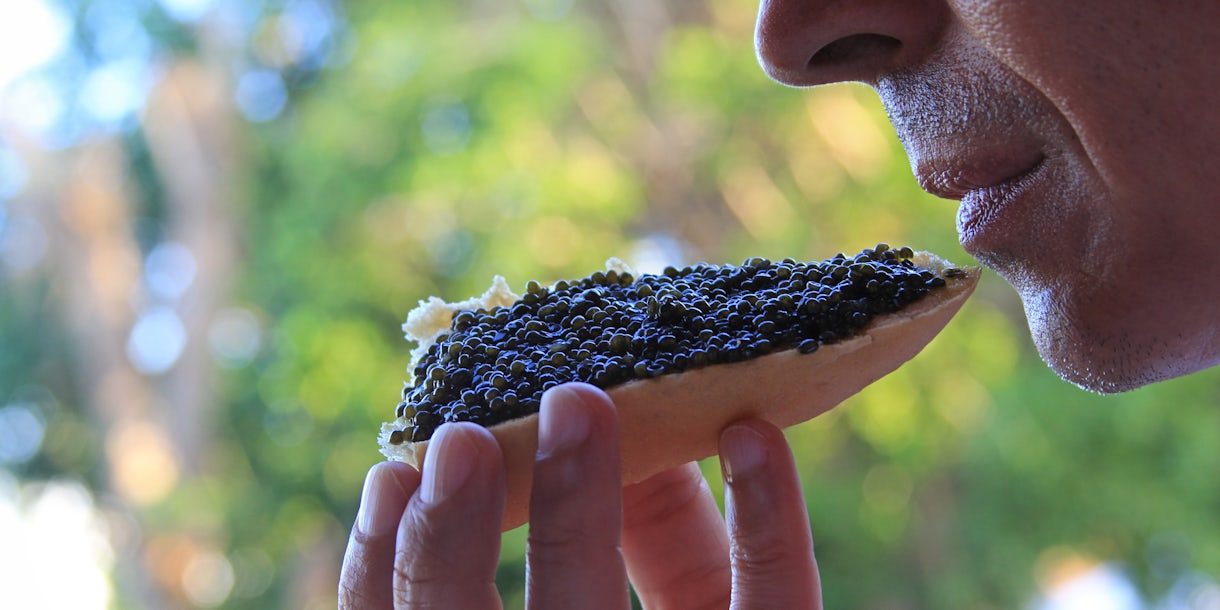
Choosing the right brand and source is key to your consumption.
I deserve this.
Many Great Ways to Eat Caviar
Caviar connoisseurs will insist that the best way to eat this gourmet roe is on its own, to truly appreciate all the flavor and complexity the caviar offers. But of course, however you enjoy it comes down to a matter of preference and taste. Some people can find caviar to be a bit too potent, and accompanying it with other foods is perfectly acceptable. In fact, there are foods that are considered traditional to serve alongside caviar.
The classic Russian way is to serve and eat caviar with blinis, which are small Russian pancakes. Another way is on some dry toast very lightly smeared with unsalted butter, or on dry, unsalted crackers.
There are also the conventional garnishes, like crème fraiche, lemon wedges, crumbled hard-boiled eggs, sour cream, diced onions, mini potatoes, and fresh herbs. These, combined with caviar, can give you a great gustatory experience.
And if you want to go all out (and honestly, why not?), you can also serve caviar on top of fresh oysters—a guaranteed special and opulent experience.
No matter how you decide to enjoy this delicacy, remember to keep the caviar the star of your meal. Don’t overpower it with too many contrasting flavors, but also try not to add so much of it in one go. It’s the Queen of Feasts, and deserves to be treated as such.
Drink pairings can make or break a dining experience, and caviar is particularly picky on this front. There are two drinks that pair so perfectly with true caviar, that it will feel like finishing a puzzle with that last piece. Trust us, vodka or Champagne is the way to go.
The Russians knew what they were doing when they paired vodka with this salted roe delicacy. It’s perfect! The rich, salty flavor notes of the caviar are accentuated by the crisp booziness of pure vodka. Just make sure the vodka is very cold, and as pure and classic as you can get (avoid additives and flavorings). Wheat and rye-based vodka go exceptionally well with Ossetra caviar, in particular.
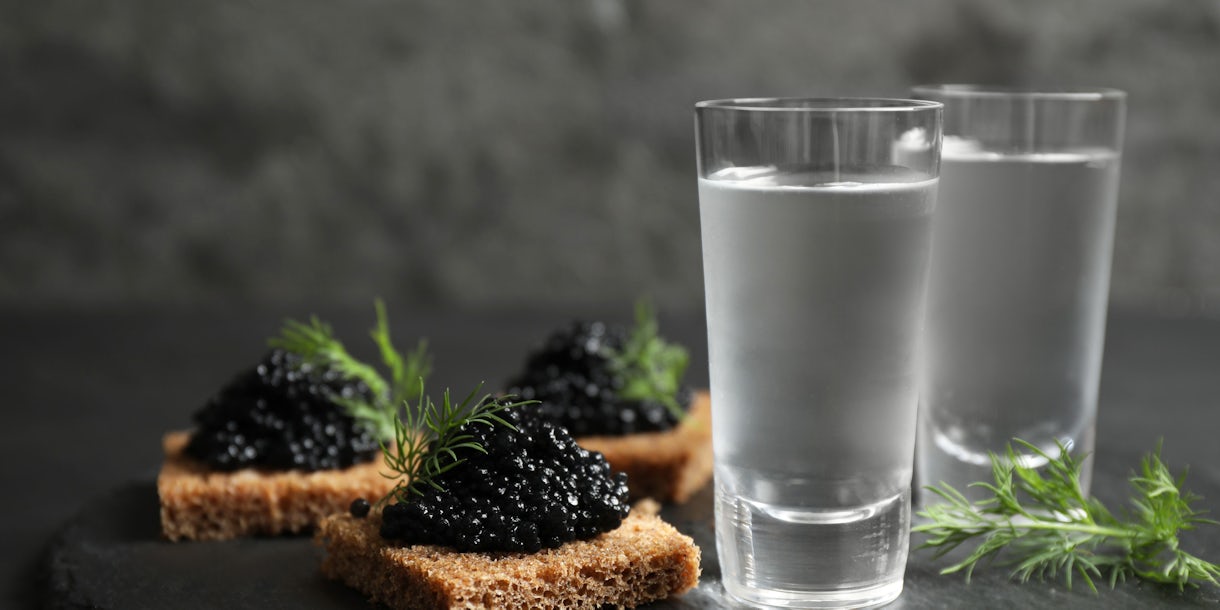
Cold Russian vodka and caviar go oh so well together.
And if there ever was a golden combination, it would be caviar and Champagne. The high acidity of the drink complements the texture of the caviar so well. Add to that, the crackling of the caviar in the mouth is similar to the sparkling feeling Champagne has, so enjoying them together is a true gastronomic delight. Make sure, though, that you avoid semi-sweet or sweet Champagne, as it is the acidity that makes it a good complement. The drier the Champagne, the better—so Brut is best.
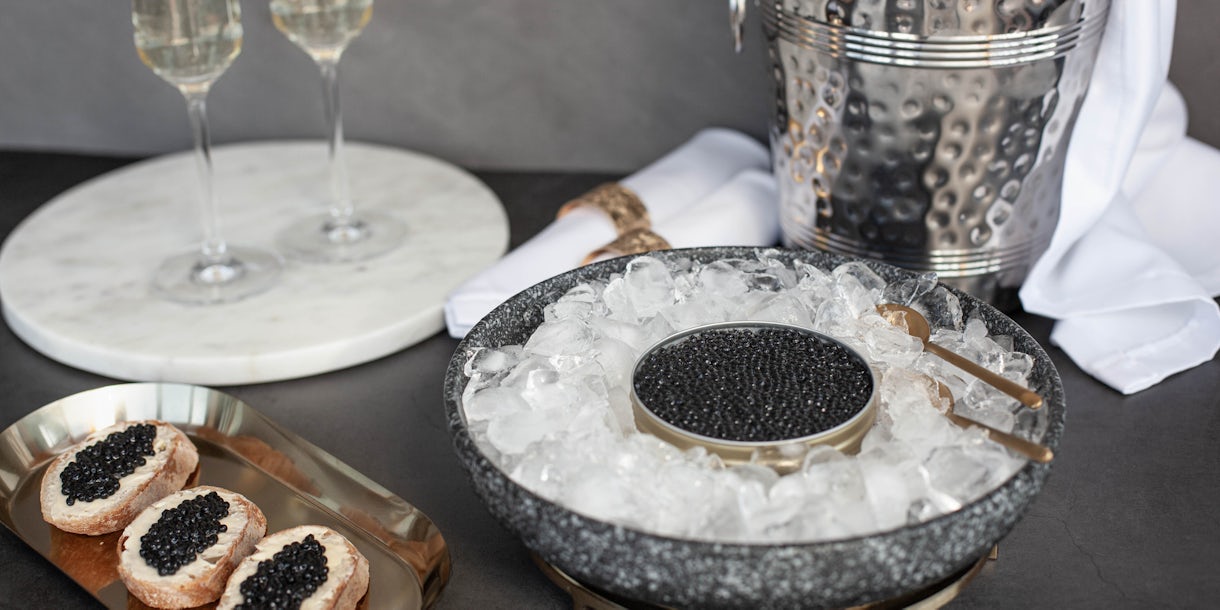
Champagne and caviar, the ultimate pairing.
In fact, for a very special occasion, you can try caviar on fresh oysters, paired with Champagne. It will have you feeling like royalty yourself.
There are many unconventional ways to consume caviar, too, especially when you have extra left over, and want to add a hint of luxury to your meals. You can have it on pasta; a lemon capellini with a dollop of caviar is incredible. Fancy up your breakfast with a plate of buttery, creamy scrambled eggs topped with sour cream, herbs, and a spoonful of caviar.
If you prefer something besides blinis or crackers to put caviar on, you can put it on potato chips. Yes, potato chips. The combination of the crispy salty chips and the briny, creamy caviar is surprisingly pleasant. You can also have it on flat bread with some smoked salmon, crème fraiche, and chives.
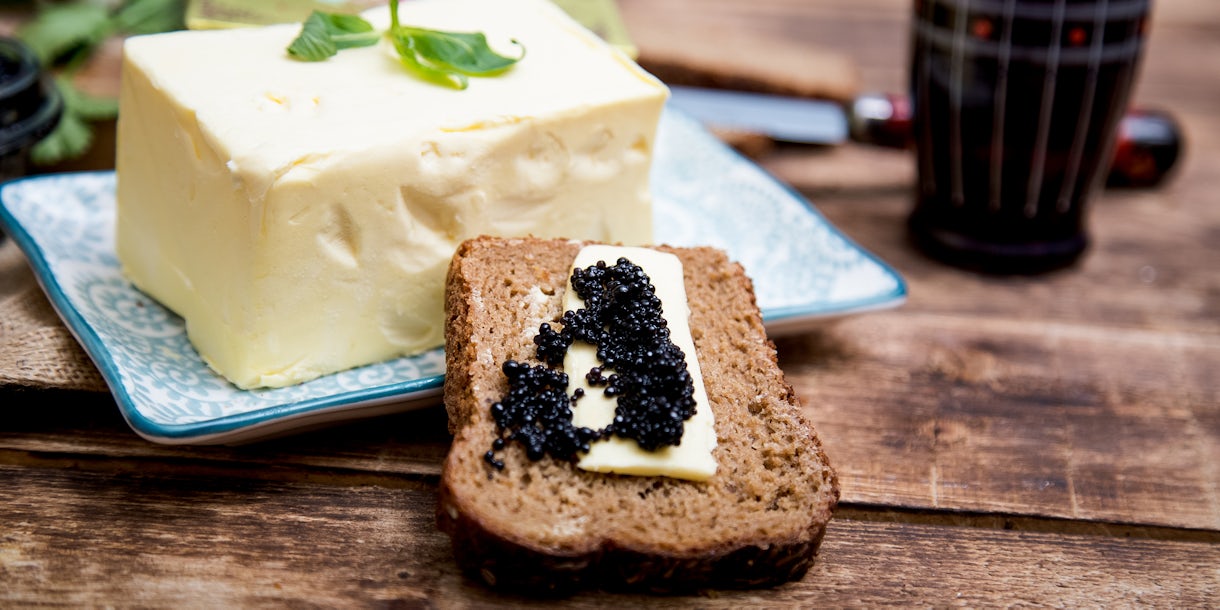
Black caviar on bread and butter.
Caviar is Good For You
Yes, aside from being a gourmet food, caviar is also good for you. Apart from being considered an aphrodisiac, caviar is loaded with Omega-3, which boosts cardiovascular and brain health and may reduce signs of skin aging. It’s also rich in Selenium, an antioxidant that helps protect cells from free radicals, and helps with thyroid health. It’s also a great source of protein, and contains Vitamins A, C, E, and B12, the latter being essential to the production of red blood cells.
Ultimately a spoonful of caviar is loaded with an impressive nutritional outline. A one (1) ounce or a twenty-eight (28.35) gram serving of caviar provides the body with the following.
• Calories: 75
• Protein: 7 grams
• Fat: 5 grams
• Carbohydrates: 1 gram
• Calcium: 78 mg
• Vitamin B12: 236% of the Daily Value (DV)
• Selenium: 34% of the DV
• Iron: 19% of the DV
• Sodium: 18% of the DV
You can check for yourself here. https://fdc.nal.usda.gov/fdc-app.html#/food-details/1099086/nutrients
However way you enjoy this ancient delicacy, one thing’s for sure: you won’t regret trying it. For something seemingly so fancy, it’s actually very versatile; dress it up like the queen it is, or enjoy it casually. From the royal banquets of the aristocracy to your own dining table at home, caviar has taken its brilliance on every kind of gustatory journey.
It’s a piece of accessible luxury, and you don’t have to buy the most expensive one to enjoy its excellence—just a real one.

